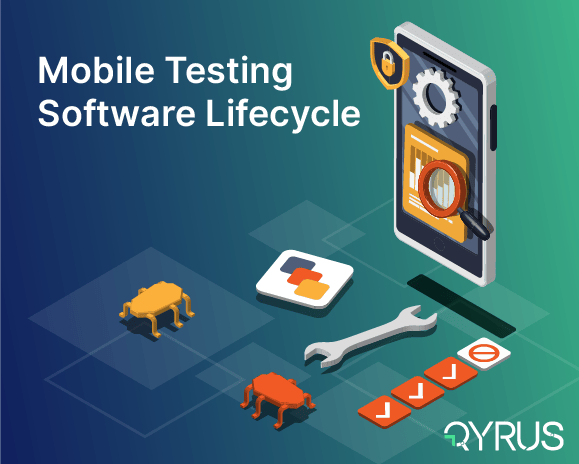The Pro’s Guide to Mobile App Testing: From Gesture to Go

Mobile apps are now the foundation of our digital lives, and their quality is no longer just a perk—it’s an absolute necessity. The global market for mobile application testing is experiencing explosive growth, projected to hit $42.4 billion by 2033.
This surge in investment reflects a crucial reality: users have zero tolerance for subpar app experiences. They abandon apps with performance issues or bugs, with 88% of users leaving an app that isn’t working properly. The stakes are high; 94% of users uninstall an app within 30 days of installation.
This article is your roadmap to building a resilient mobile application testing strategy. We will cover the core actions that form the foundation of any test, the art of finding elements reliably, and the critical skill of managing timing for stable, effective mobile automation testing.
The Foundation of a Flawless App: Mastering the Three Core Interactions
A mobile test is essentially a script that mimics human behavior on a device. The foundation of any robust test script is the ability to accurately and reliably automate the three high-level user actions: tapping, swiping, and text entry. A good mobile automation testing framework not only executes these actions but also captures the subtle nuances of human interaction.
Tapping and Advanced Gestures
Tapping is the most common interaction in mobile apps. While a single tap is a straightforward action to automate, modern applications often feature more complex gestures critical to their functionality. A comprehensive test must include various forms of tapping. These include:
- Single Tap: The most basic interaction for selecting elements.
- Double Tap: Important for actions like zooming or selecting text.
- Long Press: Critical for testing context menus or hidden options.
- Drag and Drop: A complex, multi-touch action that requires careful coordination of the drag path and duration. A strategic analysis of the research reveals two primary methods for automating this gesture: the simple driver.drag_and_drop(origin, destination) method, and a more granular approach using a sequence of events like press, wait, moveTo, and release.
- Multi-touch: Advanced gestures such as pinch-to-zoom or rotation require sophisticated automation that can simulate multiple touch points simultaneously.
The Qyrus Platform can efficiently automate each of these variations, simulating the full spectrum of user interactions to provide comprehensive coverage.
Swiping and Text Entry
Swiping is a fundamental gesture for mobile navigation, used for scrolling or switching pages. Automation frameworks should provide robust control over directional swipes, enabling testers to define the starting coordinates, direction, and even the number of swipes to perform, as is possible with platforms like Qyrus.
Text entry is another core component of any specific mobile test. The best practice for automating this action revolves around managing test data effectively.
Hard-coded Text Entry
This is the simplest approach. You define the text directly in the script. It is useful for scenarios like a login page where the test credentials remain the same every time you run the test.
Example Script (Python with Appium):
| from appium import webdriver from appium.webdriver.common.appiumby import AppiumBy # Desired Capabilities for your device desired_caps = { “platformName”: “Android”, “deviceName”: “MyDevice”, “appPackage”: “com.example.app”, “appActivity”: “.MainActivity” } # Connect to Appium server driver = webdriver.Remote(“http://localhost:4723/wd/hub”, desired_caps) # Find the username and password fields using their Accessibility IDs username_field = driver.find_element(AppiumBy.ACCESSIBILITY_ID, “usernameInput”) password_field = driver.find_element(AppiumBy.ACCESSIBILITY_ID, “passwordInput”) login_button = driver.find_element(AppiumBy.ACCESSIBILITY_ID, “loginButton”) # Hard-coded text entry username_field.send_keys(“testuser1”) password_field.send_keys(“password123”) login_button.click() # Close the session driver.quit() |
Dynamic Text Entry
This approach makes tests more flexible and powerful. Instead of hard-coding values, you pull them from an external source or generate them on the fly. This is essential for testing with a variety of data, such as different user types, unusual characters, or lengthy inputs. A common method is to use a data-driven approach, reading values from a file like a CSV.
Example Script (Python with Appium and an external CSV):
First, create a CSV file named ‘test_data.csv’:
| username,password,expected_result user1,pass1,success user2,pass2,failure user_long_name,invalid_pass,failure |
Next, write the Python script to read from this file and run the test for each row of data:
| import csv from appium import webdriver from appium.webdriver.common.appiumby import AppiumBy # Desired Capabilities for your device desired_caps = { “platformName”: “Android”, “deviceName”: “MyDevice”, “appPackage”: “com.example.app”, “appActivity”: “.MainActivity” } # Connect to Appium server driver = webdriver.Remote(“http://localhost:4723/wd/hub”, desired_caps) # Read data from the CSV file with open(‘test_data.csv’, ‘r’) as file: reader = csv.reader(file) # Skip the header row next(reader) # Iterate through each row in the CSV for row in reader: username, password, expected_result = row # Find elements username_field = driver.find_element(AppiumBy.ACCESSIBILITY_ID, “usernameInput”) password_field = driver.find_element(AppiumBy.ACCESSIBILITY_ID, “passwordInput”) login_button = driver.find_element(AppiumBy.ACCESSIBILITY_ID, “loginButton”) # Clear fields before new input username_field.clear() password_field.clear() # Dynamic text entry from the CSV username_field.send_keys(username) password_field.send_keys(password) login_button.click() # Add your assertion logic here based on expected_result if expected_result == “success”: # Assert that the user is on the home screen pass else: # Assert that an error message is displayed pass # Close the session driver.quit() |
A Different Kind of Roadmap: Finding Elements for Reliable Tests
A crucial task in mobile automation testing is reliably locating a specific UI element in a test script. While humans can easily identify a button by its text or color, automation scripts need a precise way to interact with an element. Modern test frameworks approach this challenge with two distinct philosophies: a structural, code-based approach and a visual, human-like one.
The Power of the XML Tree: Structural Locators
Most traditional mobile testing tools rely on an application’s internal structure—the XML or UI hierarchy—to identify elements. This method is fast and provides a direct reference to the element. A good strategy for effective software mobile testing involves a clear hierarchy for choosing a locator.
- ID or Accessibility ID: Use these first. They are the fastest, most stable, and least likely to change with UI updates. On Android, the ID corresponds to the resource-id, while on iOS it maps to the name attribute. The accessibilityId is a great choice for cross-platform automation as developers can set it to be consistent across both iOS and Android.
- Native Locator Strategies: These include -android uiautomator, -ios predicate string, or -ios class chain. These are “native” locator strategies because they are provided by Appium as a means of creating selectors in the native automation frameworks supported by the device. These locator strategies have many fans, who love the fine-grained expression and great performance (equally or just slightly less performance than accessibility id or id).
- Class Name: This locator identifies elements by their class type. While it is useful for finding groups of similar elements, it is often less unique and can lead to unreliable tests.
- XPath: Use this only as a last resort. While it is the most flexible locator, it is also highly susceptible to changes in the UI hierarchy, making it brittle and slow.
- CSS Selector: This is a useful tool for hybrid applications that can switch from a mobile view to a web view, allowing for a seamless transition between testing contexts.
To find the values for these locators, use an inspector tool. It allows you to click an element in a running app and see all its attributes, speeding up test creation and ensuring you pick the most reliable locator.
Visual and AI-Powered Locators: A Human-Centered Approach
While structural locators are excellent for ensuring functionality, they can’t detect visual bugs like misaligned text, incorrect colors, or overlapping elements. This is where visual testing, which “focuses on the more natural behavior of humans,” becomes essential.
Visual testing works by comparing a screenshot of the current app against a stored baseline image. This approach can identify a wide range of inconsistencies that traditional functional tests often miss. Emerging AI-powered software mobile testing tools can process these screenshots intelligently, reducing noise and false positives. These tools can also employ self-healing locators that use AI to adapt to minor UI changes, automatically fixing tests and reducing maintenance costs.
The most effective mobile testing and mobile application testing strategy uses a hybrid approach: rely on stable structural locators (ID, Accessibility ID) for core functional tests and leverage AI-powered visual testing to validate the UI’s aesthetics and layout. This ensures a comprehensive test suite that guarantees both functionality and a flawless user experience.
Wait for It: The Art of Synchronization for Stable Tests
Timing is one of the most significant challenges in mobile application testing. Unlike a person, an automated script runs at a consistent, high speed and lacks the intuition to know when to wait for an application to load content, complete an animation, or respond to a server request. When a test attempts to interact with an element that has not yet appeared, it fails, resulting in a “flaky” or unreliable test.
To solve this synchronization problem, testers use waits. There are two primary types: implicit and explicit.
Implicit Waits vs. Explicit Waits
Implicit waits set a global timeout for all element search commands in a test. It instructs the framework to wait a specific amount of time before throwing an exception if an element is not found. While simple to implement, this approach can cause issues. For example, if an element loads in one second but the implicit wait is set to ten, the script will wait the full ten seconds, unnecessarily increasing the test execution time.
Explicit waits are a more intelligent and targeted synchronization method. They instruct the framework to wait until a specific condition is met on a particular element before proceeding. These conditions are highly customizable and include waiting for an element to be visible, clickable, or for a loading spinner to disappear.
The consensus among experts is to use explicit waits exclusively. Although they require more verbose code, they provide the granular control essential for handling dynamic applications. Using explicit waits prevents random failures caused by timing issues, saving immense time on debugging and maintenance, which ultimately builds confidence in your test results.
Concluding the Test: A Holistic Strategy for Success
Creating a successful mobile test requires synthesizing all these practices into a cohesive, overarching strategy. A truly effective framework considers the entire development lifecycle, from the choice of testing environments to integration with CI/CD pipelines.
The future of mobile testing lies in the continued evolution of both mobile testing tools and the role of the tester. As AI and machine learning technologies automate a growing share of tedious work—from test case generation to visual validation—the responsibilities of a quality professional are shifting.
The modern tester is no longer a manual executor but a strategic quality analyst, architecting intelligent automation frameworks and ensuring an app’s overall integrity. The judicious use of AI-powered visual testing, for example, frees testers from maintaining brittle structural locators, allowing them to focus on exploratory testing and the nuanced validation of user experiences.
To fully embrace these best practices and build a resilient framework, consider the Qyrus Mobile Testing solution. With features like integrated gesture automation, intelligent element identification, and advanced wait management, Qyrus provides the tools you need to create, run, and scale your mobile application testing efforts.
Experience the difference. Get in touch with us to learn how Qyrus can help you deliver the high-quality mobile testing tools and user experiences that drive business success.




